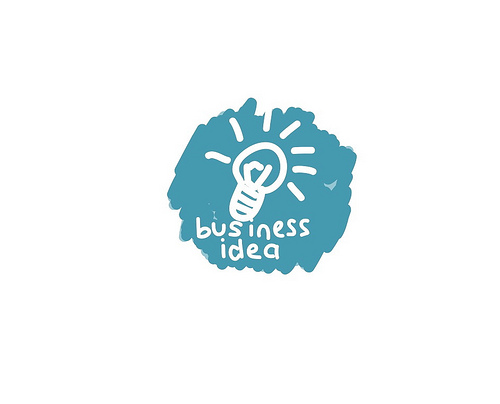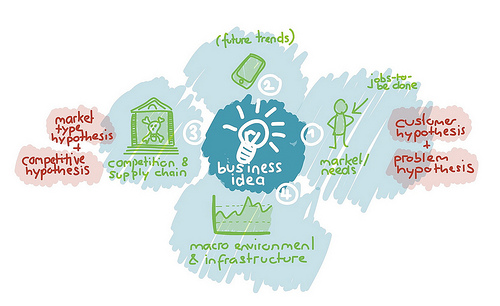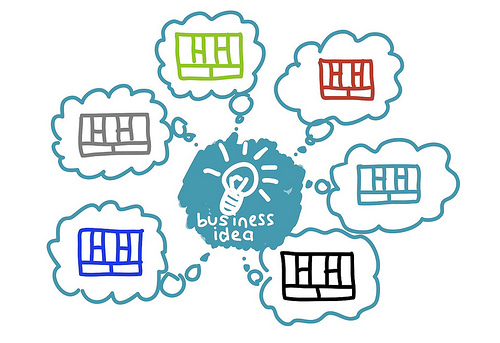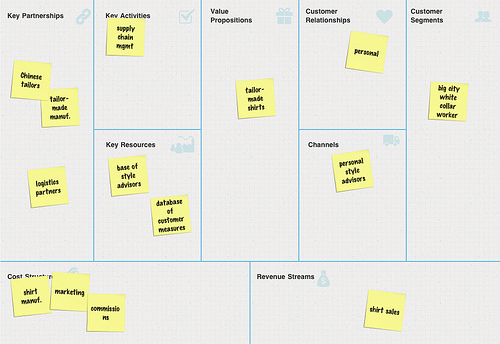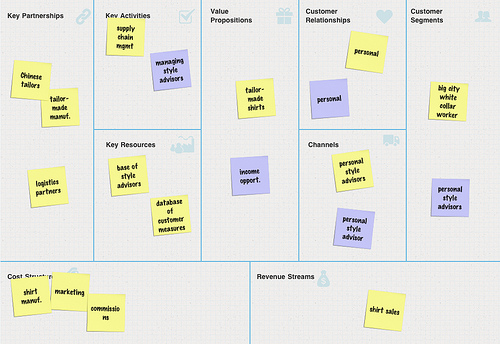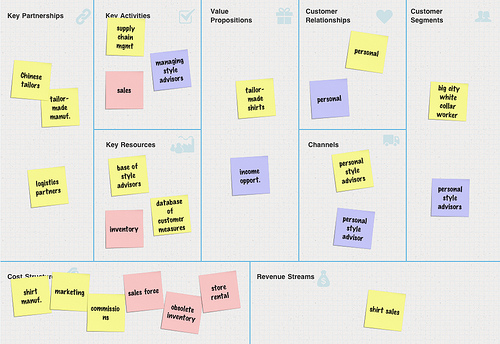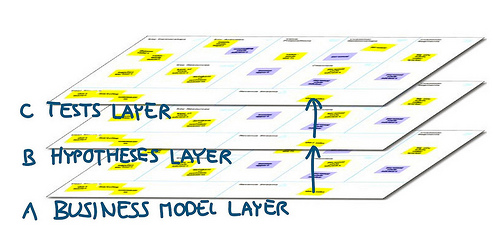Methods for the Business Model Generation: how #bmgen and #custdev fit perfectly
Blog: Business Model Alchimist
The Business Model Generation is about people who strive to defy outmoded business models. They are visionaries, game changers, and challengers who want to design tomorrow’s enterprises. To succeed on this journey they will require new tools, such as the Business Model Canvas and Steve Blank’s Customer Development. In this post I outline how they fit together.
This post comes mainly as a reaction to the various attempts by others to adapt and merge the Business Model Canvas with Customer Development for the entrepreneurial context. While it’s great and fascinating to see how people are tinkering with Steve’s and our method to adapt them for their start-ups, I am also worried that they lead young companies down the wrong path.
Steve and I have both already written about how our methods fit together here (Steve) and here (me). However, this time I took some time to sketch out a more detailed start-up process that merges the concepts and tools from Steve’s bestselling The Four Steps to the Epiphany and our globally bestselling Business Model Generation – A Handbook for Visionaries, Game Changers, and Challengers. Additional concepts and tools, such as Eric Ries’ Lean Start-up, may be added subsequently.
I will illustrate this process through the fictional story of Dave Sanburn, a former finance type based in Dallas, who decided to launch his own start-up. His entrepreneurial story all started with an unsatisfied customer need that gave him the idea for his start-up.
1) The Business Idea and Initial Stress Tests
Dave likes wearing tailor-made shirts, but sees shopping as a chore. He used to buy these kind of shirts during his business trips to London, but was never really satisfied, neither by the experience nor the price. When Dave realized that it was not so easy to conveniently find and buy tailor-mode shirts in Dallas he wondered if this could be a business idea worth pursuing.
Ideas for a business can have various origins. Sources could be:
- An unsatisfied customer need like Dave’s. In fact, many successful entrepreneurs launch a start-up because their own personal needs couldn’t be satisfied by the market.
- A technology (innovation) that allows doing business in a different or more efficient way. Think of how Skype started offering free phone calls because they used the readily available and free Internet as an infrastructure, rather than a proprietary network.
- A new product or service that the market hasn’t seen yet, or that is offered with a different or better value proposition. The Nespresso machine is an example of the former, while cheap flights by Southwest, easyJet or Ryanair are an example of the latter.
Let’s get back to Dave and help him run a first rough stress test of his business idea. Dave should look at four areas: customers, key trends (e.g. technology), competitors, and the macro environment. (These for areas are a simplification of the Business Model Environment outlined in Business Model Generation).
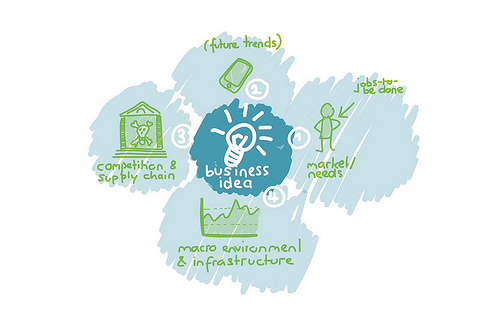
Dave should investigate a series of questions related to each of the four areas:
- Customers: Who could the customers for the business idea be? What jobs are they really trying to get done? Are there enough potential customers? Do they have buying power? Are they easy to reach?
- Trends: Could some of the key trends render the business idea obsolete in the future (e.g. tech trends, legal trends, etc.)? Are key trends going to boost the business idea in the future (e.g. socio-economic trends, etc.)?
- Competitors: Which other companies are already operating in this space? What are the substitute products and services? Which actors (competitors or partners) are key in this space?
- Macro environment: Which macro-factors must be in place to make the idea reality (e.g. infrastructure, talented employees, etc.)?
In the graphic below I added four of the concepts from Steve’s The Four Steps to the Epiphany, which I think can be of tremendous help at this stage (additions in red).
Regarding customers (right-hand side), Dave should start sketching out some first rough customer hypotheses and problem hypotheses. Steve’s book contains excellent worksheets with questions to develop the hypotheses. Regarding competition (left-hand side), Dave should add a first rough take on the market type hypothesis and competitive hypothesis.
Stress-testing the business idea is part desk-research (thank you Google) and part “getting out of the building”, to use Steve Blank’s terms. The goal of this phase is to figure out if a business idea is worth pursuing.
2) Business Model Prototyping – Generating Alternatives
After some initial research Dave decides to continue investigating his business idea. The question is: how can he offer tailor-made shirts in a viable way and how can he turn this into multi-million dollar business?
At this point many entrepreneurs fully focus on the product or service they are planning to offer. Big mistake. It’s far more illuminating to sketch out and think through several alternative business models for a product, service, or technology.
The same product, service, or technology may fail with one business model, but succeed with another. For example, few people know that Nespresso – today a 2+ billion USD business owned by Nestlé – almost failed in the late 80s because of an unsuccessful business model. With exactly the same product and technology (Nespresso machines and pods), but a very different business model, Nespresso started its global conquest of the espresso market.
I call this phase business model prototyping. It’s the one that business people and entrepreneurs struggle most with. Rather than sketching out 4-6 potential business model alternatives in 60 minutes, most people feel more comfortable merely discussing ideas or one single business model. Big mistake. It’s more valuable to have several business model alternatives on the table so you can discuss their strengths and weaknesses.
To compare the different potential business models you particularly want to play around with ballpark figures for each alternative. You can either do this with a spreadsheet or even more conveniently with our upcoming iPad app (don’t ask for the release date ;-).
3) Selecting a Business Model: Plan A
After going through several alternatives and comparing them with a set of criteria Dave has selected the one he thinks looks most promising. It’s illustrated in the next three images.
This first Business Model Canvas below illustrates the basic model of offering tailor-made shirts that are manufactured in China to white-collar office workers in big US cities. The hundred million-dollar question is of course how to reach them, i.e. through which channels?
This is where Dave’s business model becomes special. He plans to operate no stores and no sales force. His intention is to generate sales through independent “style advisers” who will earn commissions of up to 25 percent on clothing they sell.
The second Canvas illustrates the value proposition that shall attract the “style advisers” who will essentially be recruited by other advisers. Like in most direct-sales companies, advisers will get a cut of the sales made by reps they recruit.
The last Canvas shows how Dave’s company is different from most other shirt retailers. For example, he operates no stores, no sales force, and only manufactures shirts that have already been sold.
4) Testing the Business Model – Customer Development
As attractive as this first business model might look, it’s nothing else than a set of guesses. Nobody knows if it’s really going to work? This is where the real value of Steve Blank’s Customer Development kicks in. Each post-it note in the Canvas should be turned into a hypothesis and then tested. In Steve’s 4-step methodology this is the first phase called Customer Discovery.
Visually this can be represented with three layers. A first (Canvas) layer represents the business model. This is what we just outlined above with Dave’s example of a tailor-mode shirt maker. The second (Canvas) layer outlines the underlying hypothesis for each post-it note. The third (Canvas) layer turns each hypothesis into a test, so that it can be verified and measured.
Let’s briefly go through these three layers with a simple example that Dave could put in practice:
- Business Model Layer: In the business model Dave might define a price point of 150.- USD for a shirt, because he thinks his shirts need to be about 50% cheaper than a similar shirt sold through traditional retail. The profitability of his business model is calculated based on this price.
- Hypothesis Layer: The underlying hypothesis for this price point is that customers would not buy if the shirts were more expensive, but wouldn’t buy many more shirts if they were cheaper (else Dave risks leaving money on the table).
- Test (and Measurement) Layer: A way to test the above hypothesis would be a field trial with different prices. Another way to test the hypothesis would be to set-up a different websites with different prices and analyze customers’ response rates.
The challenge for Dave is to develop the three layers for each business model building block and post-it note in the Canvas ranging from customers, over value proposition, all the way to resources, and cost structure.
When Dave tests the business model with customers he is likely to modify it in an iterative fashion every time he learns more from customers. Once he thinks he’s got it right, he can continue with the remaining 3 steps of Customer Development, notably Customer Validation, Customer Creation, and Company Building.
ps
- The fictional example of Dave is based on the real-world example of Dallas shirt-maker J. Hilburn, that combines direct sales with custom tailoring. I learned about the company in a Businessweek article.
- Pardon me the typos and mistakes in this post. It’s 2am after a long day, but I just wanted to get this post out (and I definitely didn’t have the energy to re-read it)!
Leave a Comment
You must be logged in to post a comment.
